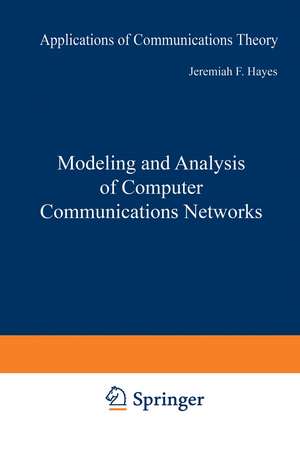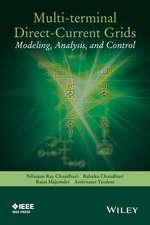Modeling and Analysis of Computer Communications Networks: Applications of Communications Theory
Autor Jeremiah F. Hayesen Limba Engleză Paperback – 31 ian 2013
Din seria Applications of Communications Theory
- 15%
 Preț: 645.60 lei
Preț: 645.60 lei - 15%
 Preț: 641.71 lei
Preț: 641.71 lei - 18%
 Preț: 956.18 lei
Preț: 956.18 lei - 18%
 Preț: 2105.61 lei
Preț: 2105.61 lei - 18%
 Preț: 1243.92 lei
Preț: 1243.92 lei -
 Preț: 393.74 lei
Preț: 393.74 lei - 18%
 Preț: 2487.11 lei
Preț: 2487.11 lei - 18%
 Preț: 953.35 lei
Preț: 953.35 lei - 15%
 Preț: 650.86 lei
Preț: 650.86 lei - 18%
 Preț: 1228.96 lei
Preț: 1228.96 lei - 15%
 Preț: 649.39 lei
Preț: 649.39 lei - 18%
 Preț: 1392.95 lei
Preț: 1392.95 lei - 18%
 Preț: 1243.92 lei
Preț: 1243.92 lei - 18%
 Preț: 963.77 lei
Preț: 963.77 lei - 18%
 Preț: 957.75 lei
Preț: 957.75 lei -
 Preț: 401.79 lei
Preț: 401.79 lei - 20%
 Preț: 346.10 lei
Preț: 346.10 lei - 20%
 Preț: 341.81 lei
Preț: 341.81 lei -
 Preț: 388.13 lei
Preț: 388.13 lei - 20%
 Preț: 339.99 lei
Preț: 339.99 lei - 18%
 Preț: 962.49 lei
Preț: 962.49 lei - 18%
 Preț: 958.56 lei
Preț: 958.56 lei - 18%
 Preț: 1394.52 lei
Preț: 1394.52 lei -
 Preț: 410.07 lei
Preț: 410.07 lei
Preț: 337.32 lei
Preț vechi: 421.66 lei
-20% Nou
Puncte Express: 506
Preț estimativ în valută:
64.55€ • 70.10$ • 54.23£
64.55€ • 70.10$ • 54.23£
Carte tipărită la comandă
Livrare economică 22 aprilie-06 mai
Preluare comenzi: 021 569.72.76
Specificații
ISBN-13: 9781468448436
ISBN-10: 1468448439
Pagini: 416
Ilustrații: XIV, 399 p.
Greutate: 0.55 kg
Ediția:Softcover reprint of the original 1st ed. 1984
Editura: Springer Us
Colecția Springer
Seria Applications of Communications Theory
Locul publicării:New York, NY, United States
ISBN-10: 1468448439
Pagini: 416
Ilustrații: XIV, 399 p.
Greutate: 0.55 kg
Ediția:Softcover reprint of the original 1st ed. 1984
Editura: Springer Us
Colecția Springer
Seria Applications of Communications Theory
Locul publicării:New York, NY, United States
Public țintă
ResearchCuprins
1. Basic Orientation.- 1.1. Modeling and Analysis of Computer Communication Networks.- 1.2. Computer Communications Networks.- 1.3. Summary of Text.- 2. Protocols and Facilities.- 2.1. Introduction.- 2.2. Properties of Data Traffic.- 2.3. Protocols.- 2.4. The Telephone Network.- 2.5. Data Transmission.- 2.6. Data Networks.- 2.7. Local Area Networks.- 2.8. Alternative Facilities: Satellites and Cable Television.- 3. Pure Birth and Birth-Death Processes: Applications to Queueing.- 3.1. Introduction.- 3.2. Bernoulli Trials—Markov Chains.- 3.3. The Poisson Process.- 3.4. Pure Birth Processes.- 3.5. Birth-Death Processes.- 3.6. Queueing Models.- 3.7. Delay—Little’s Formula.- 3.8. Burke’s Theorem.- 3.9. Communications Example.- 3.10. Method of Stages.- Exercises.- 4. Imbedded Markov Chain: The M/G/1 Queue.- 4.1. Introduction.- 4.2. The M/G/1 Queue.- 4.3. Variation for the Initiator of a Busy Period.- 4.4. Numerical Results.- Exercises.- 5. Imbedded Markov Chain Analysis of Time-Division Multiplexing.- 5.1. Introduction.- 5.2. Simple and Compound Poisson Arrival.- 5.3. Asynchronous Time-Division Multiplexing.- 5.4. Synchronous Time-Division Multiplexing.- 5.5. Message Delay.- 5.6. Alternate Derivation Average Delay in STDM.- 5.7. “Come Right In” Strategy.- 5.8. Automatic Repeat Request.- Exercises.- 6. Intermittently Available Server, Priority Queues: Application to Ring Systems.- 6.1. Interrupted Service, Priority Queues.- 6.2. Preemptive Resume Discipline.- 6.3. Nonpreemptive Priorities.- 6.4. Application to Local Area Networks with the Ring Topology.- Exercises.- 7. Polling.- 7.1. Basic Model: Applications.- 7.2. Average Cycle Time: Infinite Buffer.- 7.3. Single-Message Buffers.- 7.4. Analysis: Infinite Buffer.- 7.5. Review of Literature.- Exercises.- 8. RandomAccess Systems.- 8.1. ALOHA and Slotted ALOHA.- 8.2. Carrier Sense Multiple Access.- 8.3. Delay Calculations CSMA/CD.- 8.4. Performance Comparisons.- 8.5. Reservation Techniques.- Exercises.- 9. Probing and Tree Search Techniques.- 9.1. Overhead and Information Theory.- 9.2. Probing.- 9.3. Cycle Time in Probing.- 9.4. Message Delay.- 9.5. More Complete State Information.- Exercises.- 10. Networks of Queues.- 10.1. Introduction—Jackson Networks.- 10.2. Multidimensional Birth-Death Processes; Queues in Tandem.- 10.3. Networks of Queues—Product Form Distribution.- 10.4. The Departure Process—Time Reversal.- 10.5. Store-and-Forward Communication Networks.- 10.6. Capacity Allocation.- Exercises.- 11. Congestion and Flow Control.- 11.1. Introduction.- 11.2. Link Level Flow Control—HDLC.- 11.3. Flow Control and Jackson Networks.- 11.4. Computational Techniques—Closed Networks.- 11.5. Networks with Blocking.- Exercises.- 12. Routing-Flow Allocation.- 12.1. Introduction.- 12.2. Routing Model.- 12.3. Shortest-Path Algorithms.- 12.4. Capacity Constraints.- 12.5. Flow Control and Routing.- 12.6. Routing in Practice.- Exercises.- 13. Network Layout and Reliability.- 13.1. Introduction.- 13.2. Trees.- 13.3. Distributed Networks.- 13.4. Network Reliability.- Exercises.- Appendix A: Review of Probability Theory.- ?.1. Axioms of Probability.- A.2. Conditional Probability.- A.3. Random Variables—Probability Distributions and Densities.- A.4. Joint Distributions of Random Variables.- A.5. Expectation of a Random Variable—Moments.- A.6. Probability-Generating Functions and Characteristic Functions.- A.7. Bounds and Limit Theorems.- Appendix B: Review of Markov Chains.- B.1. Example: Bernoulli Trials.- B.2. State Transition Matrix.- B.3. Steady-state Distribution.







